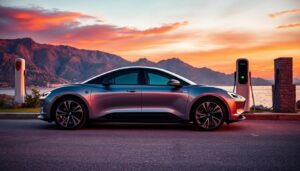Introduction
Germany is changing how we get around. The country is pushing hard to be greener and more energy-efficient. One major step forward is the rise of electric vehicles (EVs). They are now a big part of Germany’s plan to cut pollution and save energy. Over recent years, EV sales have jumped, thanks to smart government policies and better charging stations. For anyone interested—whether you are a consumer, an investor, or a policymaker—understanding this shift is more important than ever.
Germany’s Electric Vehicle Market Landscape
Current Market Size and Trends
Germany’s EV market is booming. Last year, over 600,000 electric cars were sold there, showing a big rise from previous years. Today, EVs hold around 15% of all new car sales in Germany. In comparison, traditional combustion engines are losing ground. What drives this change? It’s mainly cleaner air goals, lower fuel costs, and stricter rules on emissions. People want greener cars, and manufacturers are delivering more EV options every year.
Leading EV Manufacturers and Models
German brands are leading the way. Volkswagen, BMW, and Mercedes-Benz all produce popular electric vehicles now. For example, Volkswagen’s ID.3 and ID.4 are common sights on German roads. BMW’s i3 and i4 have also won many fans. Mercedes offers the EQ series, blending luxury with electric tech. Besides big names, startups and joint ventures are pushing innovation. This mix keeps EV choices wide for drivers and investors.
Government Policies and Incentives
Germany has rolled out many perks to encourage EV buying. The government offers purchase subsidies that cut prices by thousands of euros. Tax benefits and reduced registration fees also make EVs more attractive. Cities run special programs and pilot projects to test new charging ideas. These policies are helping more consumers switch to electric, making EVs a normal sight in cities and towns.
Charging Infrastructure Development in Germany
Public Charging Stations
Germany boasts a rapidly growing network of charging stations. There are now over 50,000 public chargers across the country. They are mainly found in cities, along highways, and near shopping centers. Not all chargers are the same; some recharge slowly with AC, while others are fast DC chargers that can give 80% charge in minutes. Strategically placed stations reduce range worries and make EVs more practical.
Home and Workplace Charging Solutions
Many Germans are installing chargers at home. Some get discounts or incentives for adding a home station. Workplace charging is also expanding, giving employees a convenient way to top up while they work. This setup is a win-win, making electric driving easier and more appealing.
Future Infrastructure Plans
Germany has big plans to add even more charging points. They aim to have 1 million chargers by 2030. The focus is on integrating renewable energy sources so that charging is even greener. Private investments and international partnerships are speeding up the process. These steps will make EV ownership simple and accessible for everyone.
Technological Innovations and Challenges
Advancements in Battery Technology
Batteries are getting better all the time. Engineers have made them store more energy, charge faster, and last longer. German companies like Volkswagen and Bosch are working on new battery tech to make EVs more affordable and efficient. This progress makes driving farther on a single charge easier than ever before.
Smart Charging and Grid Integration
Smart chargers can communicate with the power grid. This helps balance electricity supply and demand. Vehicle-to-grid (V2G) technology allows EVs to send energy back to the grid when needed. Pilot projects in Germany show how this can reduce power costs and support renewable energy use. The idea is to turn EVs into part of a smarter, cleaner power system.
Challenges Facing German EV Industry
Despite progress, hurdles remain. Sourcing enough battery materials like lithium and cobalt is tough. Supply chains get tangled, and prices can rise. Some drivers still worry about driving range and charging times. Regulations and infrastructure expansion also need to keep pace. Overcoming these issues is key for Germany to stay ahead in electric mobility.
Economic and Environmental Impacts
Job Creation and Industry Growth
The shift to EVs is creating thousands of jobs. New factories, charging stations, and maintenance centers open across Germany. Automakers see electric cars as the future, and that means more careers and economic growth. The country’s automotive sector is transforming into a green industry powerhouse.
Reduction of Greenhouse Gas Emissions
Electric cars produce no tailpipe emissions. If powered by renewable energy, they significantly cut greenhouse gases. Germany’s push for EVs could reduce transportation-related emissions by up to 40% by 2030. Over the car’s lifetime, EVs are cleaner than traditional vehicles, helping fight climate change.
Sustainability and Recycling
Germany is also focusing on recycling EV batteries. Turning old batteries into new ones reduces waste and lowers costs. Companies are developing circular economy strategies, making EVs truly sustainable from start to finish. Proper disposal and recycling ensure these vehicles help the environment without creating new problems.
Global and European Context
Germany’s Role in EU Green Deal Goals
Germany plays a big part in Europe’s climate targets. The EU plans to cut emissions by 55% by 2030, and EVs are a major tool. Cross-border projects aim to build a seamless EV charging network across Europe. This makes it easier for drivers to travel without worrying about running out of charge.
International Collaborations and Competitions
Germany collaborates with Asian EV firms to bring new tech and ideas. Meanwhile, countries like Norway and the Netherlands are competing in EV adoption and infrastructure. Germany’s smart policies and maturing industry put it ahead, but the race is still on to lead the electric future.
Conclusion
Germany is making huge strides in electric mobility. From expanding charging stations to boosting local EV manufacturing, the country shows a strong commitment to greener transport. For consumers, that means more choices and better infrastructure. Investors see new opportunities. Policymakers are shaping the future with targeted policies. The goal? Keep Germany at the forefront of electric innovation. If you’re thinking about switching to electric, now’s the time to explore your options and get ready for a cleaner, smarter drive.
As Germany leads this charge, staying informed will help you benefit from what’s coming next in electric vehicles. The road ahead looks bright—and green.




